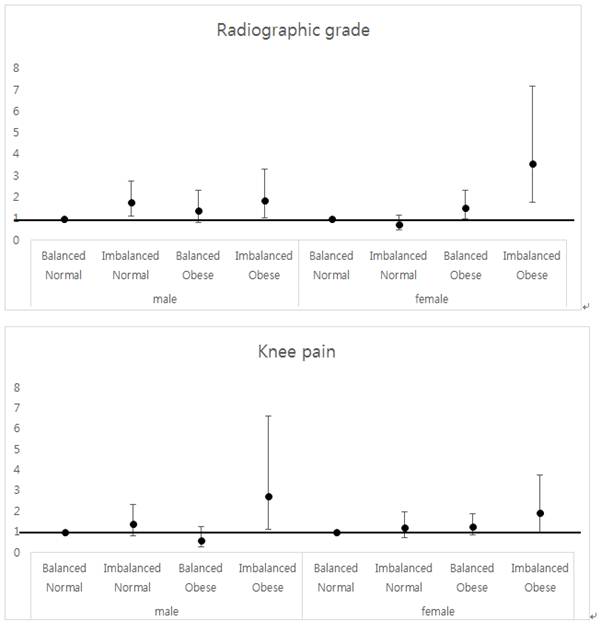Session Information
Session Type: ACR Poster Session A
Session Time: 9:00AM-11:00AM
Background/Purpose: Osteoarthritis(OA) has been recognized as a progressive disease resulting from stress in synovial joint tissues including periarticular muscles. In knee OA, quadriceps muscle mass and strength were shown to be associated with knee OA symptoms, prevalence and progression. As one of the measures to evaluate periarticular muscles in knee OA, muscle mass imbalance or difference in both leg muscles has not been investigated. Therefore, we examined if leg muscle imbalance is related to higher prevalence of knee OA and its radiographic grade as well as symptoms.
Methods: We conducted a cross-sectional study using data from the Fifth Korean National Health and Nutrition Examination Survey (KNHANES V). Males or females aged 60 years or older who underwent both knee radiographs and DXA scans were included. Patient characteristics, bilateral knee x-rays with KL grade readings, body composition by DXA scans were obtained as part of KNHANES V. Muscle imbalance index was defined as |(left leg muscle mass)/(both legs muscle mass) x 100 -50|. Statistical analyses were performed to examine the relationships between muscle imbalance index and radiographic grade and knee symptoms.
Results: Total 2,548 patients (1,126 of men and 1,422 of women) were included in the analysis. The characteristics of males and females were significantly different. Males were younger, had smaller BMI but bigger muscle mass and lesser fat mass in both legs, exercised more than female patients. Muscle imbalance index was averaged at 0.94¡¾0.03 in males and 1.04¡¾0.03 in females. The index was significantly greater in women (p=0.01). The imbalance index was positively associated with the KL grade as well as knee pain especially in males. The most imbalanced group had 2.3 times worse radiographic grade and 2.8 times more likely to have knee pain than the least imbalanced group in males. In males with radiographic knee OA (KL grade >=2), those with the highest quantile of muscle imbalance were 3 times more likely to have knee pain compared with those in the lowest quantile. When subjects were divided into 4 different groups by obesity (BMI>=25kg/m2) and the muscle imbalance index (4th quantile vs. the rest) – balanced normal, balanced obese, imbalanced normal, and imbalanced obese, those with imbalanced obese were 1.8 times or 3.6 times worse radiographic grade of knee osteoarthritis in males or females, respectively (Figure). In males, having leg muscle imbalance irrespective of their weight status related to significantly worse radiographic grade of knee OA compared with normal males.
Conclusion: Leg muscle imbalance was associated with radiographic knee OA grade as well as prevalent knee pain. In males, muscle imbalance was significantly related to worse radiographic knee grade or knee pain, whereas obesity alone was not related to neither of them.
To cite this abstract in AMA style:
Lee JY, Han K, Park YG, Park SH. Leg Muscle Imbalance Is Associated with Radiographic Grade or Pain in Knee Osteoarthritis [abstract]. Arthritis Rheumatol. 2016; 68 (suppl 10). https://acrabstracts.org/abstract/leg-muscle-imbalance-is-associated-with-radiographic-grade-or-pain-in-knee-osteoarthritis/. Accessed .« Back to 2016 ACR/ARHP Annual Meeting
ACR Meeting Abstracts - https://acrabstracts.org/abstract/leg-muscle-imbalance-is-associated-with-radiographic-grade-or-pain-in-knee-osteoarthritis/

